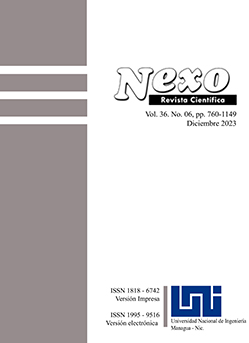Effect of curing conditions and formulation on the adhesive strength of stone-siporex mortar composite
DOI:
https://doi.org/10.5377/nexo.v36i06.17457Keywords:
Hydrated aerial lime, Melment, Adhesive strength, Tuffeau, Siporex, Relative HumidityAbstract
Background: Adhesive strength is one of the most important properties of the hardened mortar, and influenced by mortar workability (i.e. mortar water content), and substrate roughness surface degree. Objective: This study aims to measure the adhesion strength between three different hydrated aerial lime mortars, and the two most common building units in old and modern building in Loire valley in France: Tuffeau and Siporex, under different relative humidity (12,66,98%) and curing periods (7,28,90 days). Materials and Methods: These mortars include: B/F (1:5.6: Moisture=46 %, aggregate stone powder pass sieve NO.2mm), B/W (1:5.6: Moisture=44 %, aggregate stone powder pass sieveNO.2mm and retained on sieve NO. 0.16mm), and B/F/M (1:5.6: Moisture=35%: superplasticizer water reducer Melment F10 (2.5% of lime amount), aggregate stone powder pass sieve NO.2mm). Numerous complementary techniques have been used to achieve this study, such as: x-ray diffraction, coupled plasma optical emission spectrometry, mercury intrusion porosimetry, mortars axial expansion by consolidation apparatus, and Proceq-DY-215 apparatus for adhesive strength measurement. Results: The results showed that expansion of B/F, B/W, and B/F/M has little effect on their adhesion strength with Tuffeau /Siporex substrates. Also, the adopted relative humidity variations had a limited effect on the adhesion strength of B/W along the curing periods (7, 28, and 90 days), with noticeable effect for the other mortars. Conclusions: The conclusions referred to the important impact of the degree of substrate surface roughness on the adhesive strength of all used mortars, where the use of Siporex as substrate recorded a clear advantage compared to Tuffeau under all used relative humidity and curing periods.
Downloads
Downloads
Published
How to Cite
Issue
Section
License
Copyright (c) 2024 Array

This work is licensed under a Creative Commons Attribution 4.0 International License.
The authors who publish in Nexo Scientific Journal agree to the following terms:
- Authors retain the copyright and grant the journal the right of the first publication under the license Creative Commons Attribution License https://creativecommons.org/licenses/by/3.0/, which allows others to share the work with a recognition of the authorship of the work and the initial publication in Nexo Scientific Journal.
- Authors may separately establish additional agreements for the non-exclusive distribution of the version of the work published in the journal (for example, in an institutional repository or a book), with the recognition of the initial publication in Nexo Scientific Journal.
- Authors are allowed and encouraged to disseminate their works electronically (for example, in institutional repositories or in their own website) before and during the submission process, as it can lead to productive exchanges, as well as earlier and greater citation of published works.











